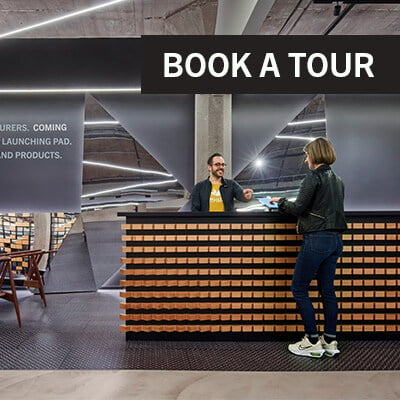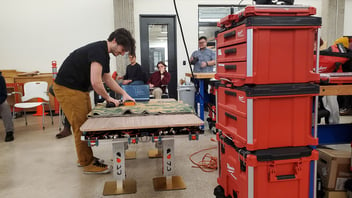For a startup, the path to commercialization is complex.
This is even more true for HardTech and hardware companies. Creating something physical means higher barriers to entry as building an MVP and being able to scale quickly is far more nuanced when launching physical products or services. From accessing expensive equipment and patents to developing supplier relationships and distribution networks, physical product development is hard.
That’s why mHUB has gathered industry experts to share their insights tailored specifically to the journey of HardTech and hardware founders. mHUB is a hardtech and manufacturing innovation center with an ongoing curriculum. This post captures some of the best advice provided through mHUB classes and puts it here for anyone to access. It includes topics relevant to all startups, such as market research, business strategy, funding, and talent, but also content specifically for prototyping, engineering, and manufacturing physical products. Dive in!
And if you’re looking for more hands-on support or to unlock further events and courses, check out mHUB membership.
General Business Strategies
• Business Modeling for Entrepreneurs
• 3 Networking Tips for Entrepreneurs
• Building Partnerships & Relationships
• Negotiation Basics
• Non-disclosure agreements for startups
• How to Become WBE Certified
• Founders’ Agreements
• Best Practices for B2B Sales
Customer Discovery & Retention
• The Role of Market Research in the Success of Your Startup
• Human Factors for Product Development
• Focus Group Testing
• Market Ready Products
• Value Proposition Design Canvas
• Selling Virtually: Putting the Buyer First
Design, Development & Manufacturing
• Journey Mapping & Design
• Designing for Product Launch Success
• Choosing the Right Materials
• Product Development: Working with Sheet Metal
• Hardware Testing: Design Validation & Data Gathering
• Manufacturing and Quality Control
• Test Plan for Product Development
• Product Safety Certification
• Supply Chain Contracts
• Exporting Basics
Funding & Financing Early-Stage Startups
• Financial Modeling
• Equity & Cap Tables
• Venture Financing
• SBIR Financing
• Grant Writing: Your idea + Your Story = Investors
• Corporate Finance Structure & Debt Financing
Human Capital & Leadership
• Growing Your Team
• Establishing and Adjusting Work Policy
• PR & Content Marketing
• Leading through Change
Business Modeling for Entrepreneurs
 Jarrod Lowery, Strategy Consultant and Business Designer, Do Tank
Jarrod Lowery, Strategy Consultant and Business Designer, Do Tank
There is a need for nimbleness and adaptability in business. One of the strongest tools in the entrepreneur's repertoire is a Business Model Canvas. When used to its full potential, Business Model Canvas helps companies align on their current state, ideate new paths forward, and design an impactful future. Think like a customer. Remember that business design thinking is always about the customer perspective. It's critical to understand the difference between a user, buyer, and financer, and how to craft a compelling story about how your solution addresses each of their goals. The business model describes the rationale of how an organization creates, delivers, and captures value.
3 Networking Tips for Entrepreneurs
 Anna Maria Viti-Welch, President, The Viti companies
Anna Maria Viti-Welch, President, The Viti companies
Network to Help People. People want to feel good. If you help them, they’ll want to help you. Check your inbox. Go through your sent and deleted emails and reach out to those you haven’t chatted with in awhile. Appearance Matters. If you’re scheduling virtual coffee meetings, think about creating your own Zoom background that showcases your brand.
Building Partnerships & Relationships
 Scott Kitun, CEO Technori
Scott Kitun, CEO Technori
Know Yourself. Before reaching out to a potential partner, know the answer to the following questions: How can I help them? How might they help me? First Impressions. You only get one real first impression, so don’t be shy in implementing off the grid ways of communication. Exercising Caution. The less you take business personally, the better off you’ll be. What to Read. Studying history, philosophy and human behavior is much more valuable when learning how to communicate and negotiate.
Negotiation Basics
 Emily Underwood, Associate Clinical Professor; Bluhm-Helfand Director, Innovation Clinic at University of Chicago Law School
Emily Underwood, Associate Clinical Professor; Bluhm-Helfand Director, Innovation Clinic at University of Chicago Law School
BATNA stands for Best Alternative to Negotiated Agreement and is something that you should always keep in mind to help you prioritize your goals. You cannot enter into a negotiation with multiple priorities! A positional approach requires both sides to trade one desired outcome in favor of another until a middle ground is reached. Use this for low intensity negotiations. A principled approach requires greater discussion with an eye toward conflict management and achieving a more mutually beneficial outcome.
Non-disclosure agreements for startups
 Heather Harper, Founder Harper Legal
Heather Harper, Founder Harper Legal
NDAs are the floor, not the ceiling of security for your business. Heather Harper of Harper Legal invites webinar participants to get a high-level understanding of non-disclosure agreements, when to use them, what to fill them with, and why we use them at all. With this knowledge, startups can ensure the protection of their property and, most importantly, their value and novelty. Non-disclosure agreements are meant to protect important, valuable information – to keep your company’s secrets. This can be kept indefinitely. NDAs are not ‘one size fits all’. Draft and use more than one NDA for all situations. Unilateral vs. Mutual Agreements. Mutual agreements should not be used unless both parties are disclosing something – choose wisely!
How to Become WBE Certified
 Karen Goldner, Managing Director of Established Business Services, WBDC
Karen Goldner, Managing Director of Established Business Services, WBDC
You need to be able to be patient and have a sustainable plan to enter corporate America after being certified. It's important to think of certification as part of a long-term strategy. In this class, Karen Goldner of WBDC Chicago shares ten steps to become WBE certified and the criteria for becoming WOSB certified. While there are many types of certifications for businesses, it’s important to understand how each certification can benefit your company when deciding which certification to apply for. Certification is an investment. WBE Certification does not guarantee or entitle your company to receive contracts.
Founders’ Agreements
 Briana Yesilli, Associate DLA Piper, Adam Spector, Partner at DLA Piper
Briana Yesilli, Associate DLA Piper, Adam Spector, Partner at DLA Piper
It's always hard to have these sorts of conversations up front, but you'll be so much happier that you did. Who should qualify as a founder? How many does a business need or be limited to? What sort of considerations need to be thought of as it concerns founders in a business? Briana Yesilli and Adam Spector of DLA Piper Law walk participants help you to tackle these and other tough questions in this high-level explanation of founders' agreements. Founders’ Agreements are documents of agreement between all founders in a company for all aspects of ownership, business, investment, IP, confidentiality, and more. Dividing Equity. Begin the conversation about dividing equity early to avoid controversy and problems down the road. Acceleration of Vesting. Acceleration is very founder friendly. Put an acceleration clause in place, even it’s a contentious point for VC investors.
Best Practices for B2B Sales
 Maureen Wozniak, Major Accounts Manager at Better Business Bureau serving Chicago and Northern Illinois, Inc.
Maureen Wozniak, Major Accounts Manager at Better Business Bureau serving Chicago and Northern Illinois, Inc.
One of the best things for sales success is enthusiasm. Business to business sales are all about understanding the needs of your target and addressing them. This illuminating webinar with the Better Business Bureau's Maureen Wozniak walks participants through the methods and means of B2B sales, how to identify and know their target markets, and how to work their way to the close. 80/20 Rule. 80% of your targets are not in buying mode. Use a CRM to keep track of those conversations. Don’t abandon them. Research! Learn the company structure. Aim high and know key names, industry, and company stats and background before making your move. Network, network, network! But don’t sell on the first conversation. Tell a story. Stories are great successes during your pitch because we’re hard-wired to remember them.
Customer Discovery & Retention
The Role of Market Research in the Success of Your Startup
 Patrick Donohue, Director of Strategic Growth at Kem Krest
Patrick Donohue, Director of Strategic Growth at Kem Krest
Understanding your market and how customers interact with your product is absolutely critical to your success. What is the best way to optimize our time and effort in search of finding our target audience? Market research, of course! Patrick Donohue educates the mHUB Community on how to conduct market research as efficiently as possible. His tip on Intellectual Property is to strengthen your IP position through market research to make sure you’re competitive, your IP is sound, and to help avoid lawsuits. Regarding Qualitative and Quantitative research: while qualitative research is the primary driver in product development, quantitative research provides confirmation, removes bias, and grounds the team. What about Online surveys? Surveys are useful and cost effective but be sure to ask the right questions. Force participants to give you conclusive results by eliminating “neutral/sometimes” options.
Human Factors for Product Development
 Rachel Aronchick, Director of Human Factors at Thrive, and Kathryn Mizuchi, Senior User Researcher, UL Emergo
Rachel Aronchick, Director of Human Factors at Thrive, and Kathryn Mizuchi, Senior User Researcher, UL Emergo
Customers need to interact with your product--make those interactions as human friendly as possible. Whether you're making wearables, IIoT, medical devices, or anything else, it's likely you're making it in service of other people. Rachel Aronchick and Kathryn Mizuchi from UL give an introduction on what sort of considerations need to be made when making products that will be used by others. Called Human Factors Engineering, this subset of design forces product designers to understand how a consumer experiences their product, so that they can be the best on the market. Human factors work is interdisciplinary between engineering, psychology, and design. It studies how people use devices and making a good product based on those findings. User testing doesn’t need to be expensive, but it needs to happen. Some is always better than none. Get your feedback early and often. Human focused design keeps the user as a primary stakeholder in your product development process.
Focus Group Testing
 James Parker, UX Researcher at Venmo, Tess Forton, Senior User Researcher at UL Emergo
James Parker, UX Researcher at Venmo, Tess Forton, Senior User Researcher at UL Emergo
Focus group testing is a flexible, yet powerful tool for understanding your customers. Even if the customer is not always right, the buyers and users of your product certainly are incredibly valuable and vital to the success of any product-based startup. UL's Emergo team--with James Parker and Tess Forton--use real world examples to bring definition to the term "focus group", examine its pros and cons, and give context to startups on how they can apply these methods to their research to solve pressing challenges and gain valuable insights. Focus groups testing as a method of data collection is cheap and scalable, allowing entrepreneurs to conduct multiple rounds for different goals and objectives pretty painlessly. Consider all the things you’ll need for focus group testing sessions. For example, you might find that recording A/V can assist you for reviewing and making sure you didn’t miss any important points brought up during the focus group session. Ask open-ended, unbiased questions that prompt participants to give honest and thorough opinions.
Market Ready Products
 Jeff Paykin, CEO Outcome Partners
Jeff Paykin, CEO Outcome Partners
Developing a good product is obviously key, but don't let sales take a back seat. In fact, it may be more important to first finalize the sale than the product. Test the Demand. Test, Test, Test. Ask your consumer what your product is worth and really engage with your end customer to establish demand and pricing. Use the Magic Door Test. This test suggests setting up a landing page on a website to drive traffic and create calls-to-action for statistical feedback on interest and potential pricing. The Bottoms Up approach for testing means building an email list and interviewing your end customer and getting as much feedback as possible. Before investing capital into your first run, get a letter of intent or money from buyers.
Value Proposition Design Canvas
 Jarrod Lowery, Strategy Consultant and Business Designer, Do Tank
Jarrod Lowery, Strategy Consultant and Business Designer, Do Tank
The value proposition uses simple structures for complex conversations. Before pitching our products, we need to understand what problems they solve. This interactive class with Jarrod Lowery, Business Designer at Do Tank, guides participants through a lesson in understanding the value of their products. The Value Proposition Canvas is perfect for growing client accounts, redesigning conversations with your customers, and helping you better understand your competition. VPD canvases don’t answer who to serve, but how to serve. A perfect pitch considers customers objectives, pains, gains, and offers solutions.
Selling Virtually: Putting the Buyer First
Eric Bloomberg, Enterprise Account Manager, North America Global Accounts, LinkedIn
Now more than ever, startups need to rely on the virtual world to conduct their businesses. This pivot to all things digital includes one of the most important aspects of running a product- based startup: sales. The first sales call is not about you and what you’re selling. It’s about your prospect. The best sellers in the room are those that uncover buyer needs. When selling virtually, your camera should always be on for virtual meetings. Lightheartedly encourage prospects to do the same. Ask the important questions. This way, you can prescribe your product as the solution.
Design, Development & Manufacturing
Journey mapping & design
 Jeff Blanchard, Director of Product Design, Highland Solutions
Jeff Blanchard, Director of Product Design, Highland Solutions
A design sprint is a dojo to do focused design work. The jump from an idea to a finished product can be a difficult road to navigate. Jeff Blanchard from Highland Solutions walks participants through the smaller but equally important in-between steps--from prototyping to testing--in this insightful webinar about how to use Journey Mapping and Design to ensure your best product design work. Design sprints allow entrepreneurs to rapidly ideate and test without much sunk time or cost. Design can be democratized – include everyone in your company from visual designers to C-suite to provide all manner of fresh perspectives. Learn from or “remix” already existing products in “lightning demos” to gain new insights.
Designing For Product Launch Success
 Jim Shaw, Managing Director, Fastway Engineering
Jim Shaw, Managing Director, Fastway Engineering
Error is the most expensive part of production. Product launch can be daunting and costly, but it doesn't have to be. Fastway Engineering's Jim Shaw presents webinar attendees with insightful tips and tricks to help mitigate risk, cost, and fear when beginning production of your product. Launching a product has costly implications. This is not the time to continue iterating. CAD data & renderings are the beginnings of your major IP. Be detailed and treat your renderings like legal documents. Be sure to recover the Solidworks file from contractors; it will be costly to start over without them. Tolerance, or the range of acceptance of variation when engineering your product, is directly related to cost.
Choosing the Right Materials
 Sarah Severson, Founder of RIGHT MTRLS
Sarah Severson, Founder of RIGHT MTRLS
What costs you $1 today, can cost $1,000 tomorrow. So choose wisely now. Founder and principal materials engineer of RIGHTMTRLS Sarah Severson leads mHUB members through the process of material selection including considerations to make when deciding, when and where to source, and what to do to make sure you get a great iteration of your product, while ensuring you don't break the bank getting there. When it comes to materials evaluation and selection, here are three key considerations. Having good materials doesn’t make up for poor mechanical design. Check all aspects of your design before changing its materials. Think about your acquiring your materials promptly. Waiting can make your product much more costly to produce. Don’t immediately purchase your materials from 3rd party sellers like Amazon. Avoid buying counterfeit materials by contacting raw material manufacturers and providers.
Product Development: Working with Sheet Metal
 Jim Shaw, Managing Director, Fastway Engineering & Mike Tummillo, Cofounder of Prismier
Jim Shaw, Managing Director, Fastway Engineering & Mike Tummillo, Cofounder of Prismier
Sheet metal is tough, durable, and can handle extreme environments. Fastway's Jim Shaw and Prismier's Mike Tummillo discuss the pros and cons in using sheet metal for prototyping and product development. Simulation. Sheet metal lends itself well to computerized simulation that can help cut down mistakes and the need for repeated iterating. Fabrication and Stamping are methods of production for sheet metal. What can be fabricated can be stamped, but what can be stamped can’t always be fabricated. Supply and Demand. Make sure your supplier understands your product and that you prioritize relationship building with them.
Hardware Testing: Design Validation & Data Gathering
 Jim Shaw, Managing Director, Fastway Engineering
Jim Shaw, Managing Director, Fastway Engineering
Testing should have been prepared for and thought about long before the phase. Having testing procedures in place much before testing will ensure higher success. This course from Jim Shaw of Fastway Engineering teaches participants the steps in creating a successful test plan as well as best practices when it comes to design and gathering data. It’s important to create a test plan via spreadsheet. Ask yourself what you’re going to investigate, how you’re going to investigate it, and how you will interpret the data. Expect your tests to fail. Test reports are the most important part of the testing process. It can save you a lot of time in the future. Performance is a relative measurement.
Manufacturing and Quality Control
 Jim Shaw, Managing Director, Fastway Engineering
Jim Shaw, Managing Director, Fastway Engineering
How well does the product you deliver perform as advertised? Consistency is key. In this class, Jim Shaw helps us to define "Quality", identify proven and successful processes, and the pros and cons of these general processes. The process to ensuring an awesome project includes 4 steps: planning, assurance, control, improvement. A great starting point to mastering your Quality Control processes is becoming ISO Certified. When meeting with a manufacturer, ask “What’s your CPK?”. It shows you’re knowledgeable and that the manufacturer is too.
Test Plan for Product Development
 Deborah Brown, Manufacturing, Product Design, & IoT Product Leader at Bosch USA
Deborah Brown, Manufacturing, Product Design, & IoT Product Leader at Bosch USA
Quality testing will test your mettle. Expect failure before achieving success. It's important to know what is in your control and what is out of it when it comes to the crucial step of testing the quality and success of your product. This webinar with Deborah Brown discusses the necessary elements of the Test Plan and the implications this plan has on the trajectory of the development of your product. A Test Plan includes the Purpose, Procedure, and Requirements to address Performance, Quality, and Safety Compliance. Document your testing. Write down everything! For product testing, be safe, be legal, and be cognizant of your customer. Voice of the Customer is a vital consideration. Be sure to understand and include it in the very beginning of your process and throughout.
Product Safety Certification
 Manas Mehandru, Chief Operating Officer at mHUB
Manas Mehandru, Chief Operating Officer at mHUB
If you're making specific claims, the most important thing is to get them validated. After validating your market and establishing demand, it's important to make sure that product meets safety requirements. Manas Mehandru holds a dialogue with participants concerning what sorts of products need certifications, which do not, and what entrepreneurs can do to get the process going to getting safe products on shelves. For many products there is no immediate hazard, but these certifications can help protect your claims and your product. If you’re creating medtech, you must have your certifications as the risk with medical devices to consumers is the greatest. Test your market and get a feel for interest and demand before acquiring often costly certifications.
Supply Chain Contracts
 Natasha Adler, Senior Business Law Attorney at Buckley Fine, LLC focusing on Corporate Law, Mergers, Acquisitions, Commercial Real Estate, Succession Planning, and Dispute Resolution
Natasha Adler, Senior Business Law Attorney at Buckley Fine, LLC focusing on Corporate Law, Mergers, Acquisitions, Commercial Real Estate, Succession Planning, and Dispute Resolution
Make sure your contract is comprehensive, valid, and enforceable. Natasha Adler of WPD Legal invites webinar participants to consider the ins, outs, and less-considered aspects of developing a comprehensive supply chain contract. In so doing, startups position themselves for production and distribution success and can better prepare for unplanned pitfalls. Diversify, diversify, diversify. Diversifying your supply chain will help to implement good supply chain practices and minimize risk. If it matters, describe it. Always feel free to attach materials as separate documents to the contract, but be careful not to embed everything within the contract language, in case things change. Managing supply chain in a crisis. Be sure to communicate to all parts of your chain from the supplier to the distributor to the customer and bring your support to their operational challenges.
Exporting Basics
 Bill McNamara, Director at Illinois SBDC International Trade Center at the Women's Business Development Center
Bill McNamara, Director at Illinois SBDC International Trade Center at the Women's Business Development Center
The biggest question exporting can answer for your startup is 'How will I grow?'. Depending on your product or the trajectory of growth of your startup, your sights may be set abroad for new markets. Still not convinced? In these tips below, Bill McNamara, makes a case for exporting as a next step in the growth and success of your business and argues that even now is as good a time as any to start the process. Going international is hard work, but it can also be good business. There are a few questions to ask yourself before beginning your export journey, including questions on capacity and capability, if you have a plan in place, and are the resources available? Do market research first and foremost to make sure you’re making the correct exporting decisions for your business. You may need to acquire an Export License or meet other requirements as required by US law or ITAR regulations. Change with the Seasons. Exporting can even out the loss of profit, for example, if your product does better in particular seasons in particular places. Infrastructure is important. Foreign channel design and structure is critical. Get started on that early. E-commerce. If building a physical infrastructure abroad is too daunting to start, begin with virtual storefronts as a god first step!
Funding & Financing Early-Stage Startups
Financial Modeling
 Troy Henikoff, Managing Director MATH Venture Partners
Troy Henikoff, Managing Director MATH Venture Partners
Profit is a matter of option, cash is a matter of fact. Financial models make you smarter about business predictions. Investors expect you to have a solid model as you pursue funding. Your predictions will never be 100% accurate, but effective models are developed from scratch and updated monthly.
Equity & Cap Tables
 Briana Yesilli, DLA Piper
Briana Yesilli, DLA Piper
Entity selection is perhaps the most critical step in growing your business. Choose well. Getting investments as an early-stage company can be challenging--don't let equally difficult legal concepts add to the challenge. Briana Yesilli of DLA Piper leads participants in this informative class on Equity and Cap Tables, which teaches us the concepts behind legal language, and how to organize your company to attract investment. Looking for VC funding? Emerging growth companies can be best benefitted by adopting a C-corp legal structure. SAFEs and Convertible Notes are quick, easy, and company friendly ways to get money in the door. Once you start issuing equity, keep organized with the appropriate software platform to keep investors, employees, lawyers, and third parties in the loop.
Venture Financing
 Jason Franklin, MD at WV Ventures, ex-Investment Partner @ a16z, Staff Scientist @ Stanford CS, CMU CS Ph.D., Allen Newell Award Winner
Jason Franklin, MD at WV Ventures, ex-Investment Partner @ a16z, Staff Scientist @ Stanford CS, CMU CS Ph.D., Allen Newell Award Winner
The goal of fundraising is to simply get it done. Before pitching our products, entrepreneurs need to understand what problems they solve. This seminar with Jason Franklin, CEO of WV Ventures, informs the audience on the do's and don'ts of securing venture capital. Cold emails are often ignored - get a warm introduction to increase your changes of a meeting. Ensure investment is not just about identifying a good VC firm for your business. Research and connect with portfolio companies that are like yours to have a blueprint for success. Once you pique investor interest, don’t let up! Signal that interest to other firms (subtly) to dive competition.
SBIR Financing
 Sandra Hryniewicz, Innovation Process Manager at Inspiralia USA
Sandra Hryniewicz, Innovation Process Manager at Inspiralia USA Simplifying the Small Business Innovation Research Program. Navigating and applying to the SBIR program can be incredibly challenging. Getting SBIR funding is all about being able to justify your case well. Here are 3 tips from Sandra Hryniewicz, Innovation Process Manager at Inspiralia USA. Get the News. Subscribe to the agency's newsletter for targeted updates on topics. Make and informed choice. There are a multitude of agencies within each department with varying functions. Pay attention to these differences and how your project relates. Most importantly, take it Step by Step. Go in Phase order! See the upcoming mHUB event listings to check the next class offered that demystifies the SBIR financing process and gives guidelines on the hows, whens, and whys of applying for SBIR funding.
Grant Writing: Your idea + Your Story = Investors
 Michelle Sherbun, PCC, ELI-MP, President of Michelle Sherbun, LLC
Michelle Sherbun, PCC, ELI-MP, President of Michelle Sherbun, LLC
We are a culture of stories. The heart is what compels the gift. Grant writing can be difficult to tackle with little experience, so expert consultant Michelle Sherbun gave us key insight on how to share your story with possible investors, as well as how to develop your grant narrative for the future. SOCO. Single Overriding Communications Objective. Your SOCO is the one single message or set of messages you want communicated about your company and your product. The Case Statement. Rationale for your fundraising effort, your big picture, and emotions. Inspire and Persuade. Ethos, Logos, and Pathos. Must have all three!
Corporate Finance Structure & Debt Financing
 Javier Placencia, Senior Small Business Relationship Manager at Midland States Bank
Javier Placencia, Senior Small Business Relationship Manager at Midland States Bank
Your banking relationship is just as important as getting into business with a partner. Figuring out how to finance your business can be tricky, but Javier Placencia of Wintrust sheds some light on how to go about debt financing, how to foster good business practices and relationships with your bank, and how to do this as the world is changing in uncertain ways in this webinar. 5Cs of Credit. Remember your 5Cs – Capital, Condition, Character, Collateral, Capacity. Banks will be looking at these when making their decisions about financing your company. Conduct due diligence. Pull credit reports and tax transcripts beforehand and find out what services a bank can provide, like “at home” deposit services. Be prepared. Banking isn’t excluded from the massive impact the pandemic has had on industry. Come prepared to answer tough questions about how you’ve fared and your trajectory.
Human Capital & Leadership
Growing Your Team
 Natalie Lynch, Senior Manager, Talent Acquisition, LinkedIn
Natalie Lynch, Senior Manager, Talent Acquisition, LinkedIn
Talent acquisition is dynamic...just like people. Culture is in a constant state of evolution, but Values never change. Start with solidifying your values to inform how and who you hire. Bringing your current employees into the hiring process is not wasting anyone’s time – include them! This will give your prospective employee insights into their potential coworkers and help your current employees enforce company values and culture. Convince prospective employees that your company is a great fit by knowing your mission and your story and be passionate about it.
Establishing and Adjusting Work Policy
 Charles Mudd, Founder of Mudd Law
Charles Mudd, Founder of Mudd Law
Establishing and maintaining good work policy isn't political or personal, it's good business sense. Founder and principal attorney of Mudd Law, Charles Mudd walks participants through changing our official policies, manuals, and legal documents to reflect the change we're seeing in the world. This virtual seminar gives an in-depth look into all things a company should consider during these times. Make sure you always save room in your work policy - whether it be employee manuals or other documents – for contingencies. Determine who your “key” employees are for any given task, project, or information set and release access to these secure or confidential items accordingly to avoid confidentiality or security breaches, especially if you’re adopting a work-from-home policy. Be sure to look in on insurance options, particularly disability insurances to protect individuals and your company.
PR & Content Marketing
 David Kelbaugh, CEO Tacklebox
David Kelbaugh, CEO Tacklebox
You can't turn customers into advocates without a strong brand. In order to market to our customers, we have to find them first. This step by step class with David Kelbaugh, CEO of Tacklebox, works with participants on how to find their target audience and how to market to them. Surveys are a great way to reach your target audience. Creating a persona for your brand is the most efficient way to use your marketing dollars. The creation of social media accounts and a press kit are crucial in increasing brand awareness.
Leading through Change
 Kirsten Ramos, President Elevate Performance Solutions Inc.
Kirsten Ramos, President Elevate Performance Solutions Inc.
Fail fast, learn from your mistakes, and move forward. As president and coach at Elevate Performance Solutions, Kirsten Ramos says it best--"All change is personal. "But that doesn't mean it should be difficult to navigate. This webinar gives us a definition for change, how it impacts ourselves and our lives and what we can do to combat its negative effects and embrace its positive ones to be a leader who impacts successfully and positively. People need to feel informed and included. Even if your answer to a question is “I don’t know”, make sure you communicate with your team. Everyone copes with change differently. This is incredibly important to managing a team through crisis and change. Provide space to fail. It might seem counterintuitive but allow mistakes and risks to open the way for future success.





